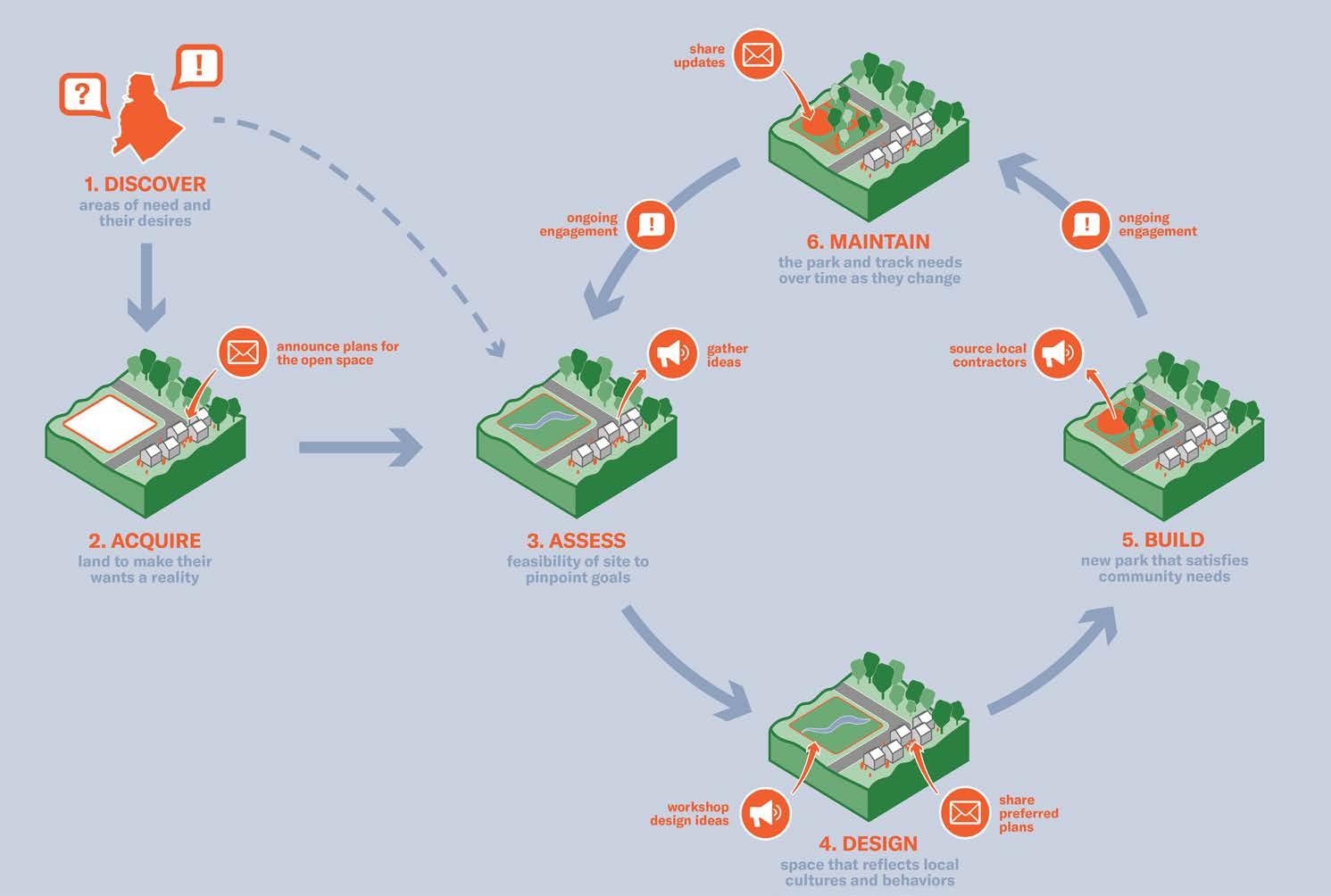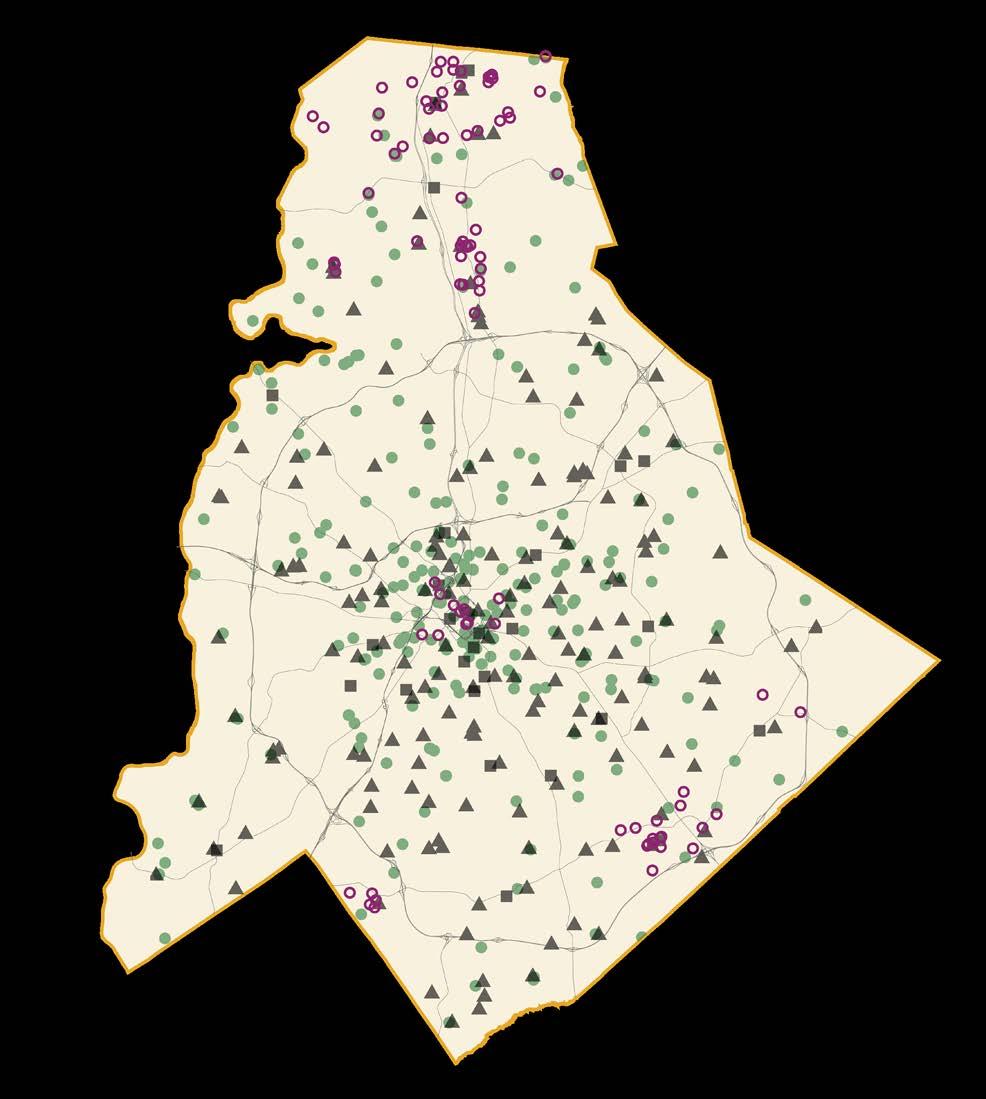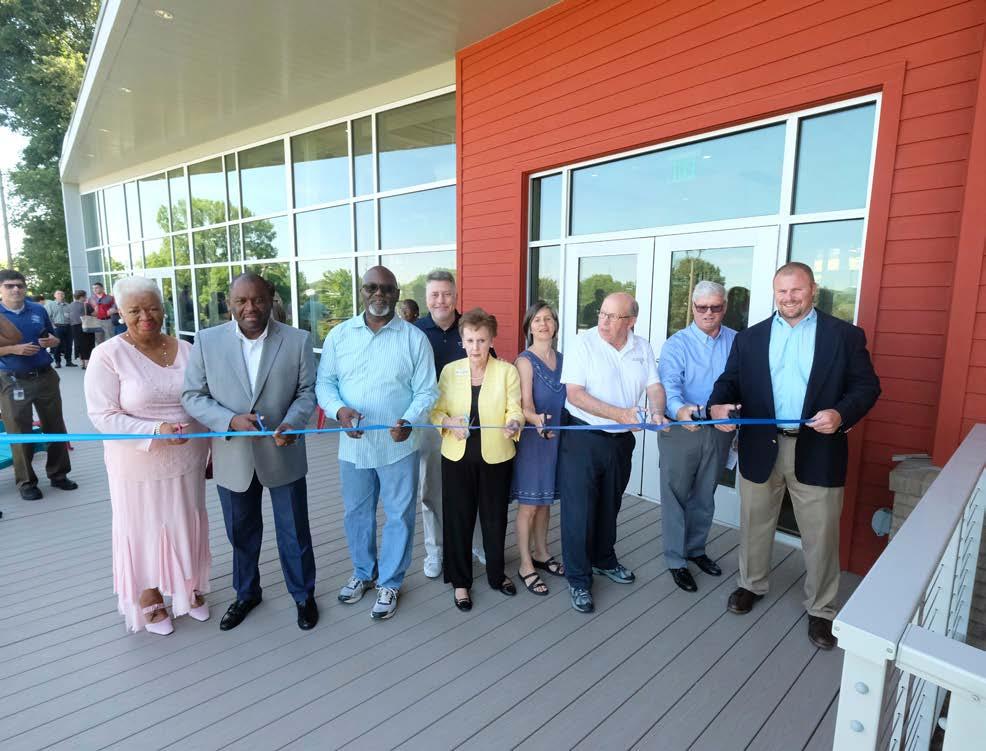
11 minute read
Goal #1 Engagement
Goal #1 Engagement Enhance relationships with diverse audiences and communities and incorporate their perspectives into each project or plan.
1.1 Create guidelines for engaging and reporting back to neighborhood residents regularly to ensure local needs are understood and met.
Advertisement
Engagement Framework
Community engagement is much more than public meetings and pop-up events. It is a process of building community relationships, sharing information, and – ultimately – feeding community input into decision-making processes. The core vision of Mecklenburg Park & Rec is around ensuring that residents have great park, trail, recreation, and naturebased experiences. However, this cannot be achieved without conversations that inform decision making and ensures that Mecklenburg Park & Rec’s services meet community needs. Community members and the Park and Recreation Advisory Councils have expressed a desire for engagement to go beyond meetings that are only about specific sites. Instead, the aim of this strategy is to transform decision making to be more transparent and communicate decisions on a regular basis. The goal is to provide the public with greater context for Mecklenburg Park & Rec’s rationale and process of decisions. As planning for open space and recreation resources becomes more sophisticated and communities increase in diversity, engagement also needs to respond in kind. This means borrowing from technology for transparent communication and ensuring staff have the tools to effectively communicate, listen, and build rapport. Rather than creating a unique engagement strategy for each capital project that arises, cities like Raleigh, North Carolina, and Portland, Oregon, have created comprehensive public engagement policies that clearly state the organization’s engagement mission and approach to fairly and equitably maximize resident input and support. In July 2020, the City of Raleigh published a Community Engagement Process Development Public Participation Playbook10 to study best practices for outreach and create a standard process for City of Raleigh projects.
Measuring and Tracking Progress
Mecklenburg Park & Rec also needs mechanisms to track community conversations to make sure a diverse pool of residents are being heard and to communicate the outcomes. Expanding the ways for the community and Department to interact is the first step for building trust and strong relationships. The next step is to coordinate this with increased research, evaluations / surveys, and other data gathering to better understand, track, and reflect on diverse community needs. For example, Oregon Metro, Portland’s regional planning organization, publishes a public engagement survey and annual report each year, acknowledging that the ongoing success of
announce plans for the open space owned and led by Capital Planning
2.1 When the community provides feedback at each step of the process, the open space and recreation system becomes a co-designed and co-implementation process.
their public engagement depends on consistent and effective communication with the public. The annual survey helps them understand how community members prefer to be reached and checks in on awareness of projects and programs. The annual report is an important summary for the public of project evaluations, objectives, levels of involvement, methods, and outcomes. Similarly, The Capital Project Tracker for the New York City park system is an example11 of a simple online database that provides access to all project information in one place.
1.1 Key Actions
Develop an engagement framework or plan that contains:
• Guidelines for best practices, formats, methods, and techniques that have been most effective with the Mecklenburg community.
• Policies or principles of public participation to clarify purpose and roles of responsible parties.
• Manual describing information on processes and procedures.
Measure and track engagement progress through four steps:
• Proactively build and maintain a database of active community members, their neighborhoods, and how they are engaged. Using that database, document which communities are receiving information, and those who are engaging with Mecklenburg Park & Rec.
• Use demographic information to align resident representation on the Park and
Recreation Commission and Advisory
Councils with the communities that they are serving. • Regularly attend and engage with community organizations, taking advantage of those that represent multiple neighborhoods with shared interests. For example, the North End
Community Coalition, Plaza Eastway
Partners, Steele Creek Residents
Association, and Historic West End.
• Develop a web-based CIP and Deferred/
Reinvestment Projects Tracker documenting current, future, funded, and non-funded projects across Mecklenburg
County to transparently share information with the community and make it clear what improvements they can expect and how they can participate.
1.2 Hire staff to strengthen the Mecklenburg Park & Rec’s internal capabilities for outreach and engagement to develop sustaining community relationships.
Outreach and engagement are always critical to a successful department - not just during a master plan process. By better understanding how communities organize and share information, Mecklenburg Park & Rec can do more effective and efficient outreach and meet community needs. Fulfilling this goal will require both dedicated staff time and specialized knowledge. At present, staff play many roles. Yet, there are no staff solely dedicated to forming relationships with community members and organizations, maintaining them, and helping to shape outreach and engagement. It will be challenging to try to create a strong community relationship while lacking the staff resources to truly do the work. In comparison, many park and recreation organizations of similar scope and size have an Community Engagement Liaison that is focused on connecting with the community and providing informational updates on a regular basis. With many staff members already serving multiple roles, new staff should be added to serve this purpose. It is recommended the Liaison begin as a single position based in Capital Planning, where there is both regular funding and regular community engagement. Over time, the role will mold into a Liaison team, transitioning to a department wide resource.
Portland Parks and Recreation relies on a Public Involvement and Community Engagement Manager to set over-arching engagement policies and collaborate with teams on strategies and implementation of community engagement processes on all planning and design efforts. This staff member has enabled Mecklenburg Park & Rec to develop a public involvement policy, toolkit, and manual to better support the broader team’s engagement, increase its effectiveness, and to coordinate efforts and messages. This staff member can also help broaden engagement training to the other staff who have community-facing roles. In implementing this strategy, there are opportunities to create solutions to potential technological and language barriers that could inadvertently limit input from some participating. For example, distributing bilingual paper copies of surveys or plans could provide more input options for limited English speakers with limited access to online resources.
1.2 Key Actions
Hire a Community Engagement Liaison:
• Create a single position located within the Department to directly support engagement on capital projects, programming, and other Department services. Initial focus of this role should be on capital projects and reinvestment projects.
• Ensure the position works closely with the future Marketing team.
• Grow the Engagement Team over time, with support members and additional responsibilities.
1.3 Formalize partnerships to increase accessibility of Mecklenburg Park & Rec offerings and expand its capacity to deliver authentic, relevant programming to local communities.
Mecklenburg Park & Rec programs and activities are a priority choice for numerous families in the County. Fortunately, there are many opportunities to take advantage of the array of services. However, population growth is causing an increase in demand coupled with a dwindling of resources. With some agile and creative thinking, Mecklenburg Park & Rec can continue to provide quality programming. One way is through partnerships. Collaborating between both internal departments and external stakeholders, similar providers, and communitybased organizations will foster a greater sense of community, provide enhanced community services, and create fiscal efficiencies. One of the barriers to effective expansion is program space. Establishing partnerships with existing private, public, and non-profit organizations is the most cost-effective way to expand programs (See Figure 2.2, Strategies 14.1 and 16.2). As part of the Meck Playbook process, a similar provider analysis was conducted. This effort revealed a vast array of private, non-profit, and other public/municipal recreation service providers in the area. Areas of programming that were analyzed included youth basketball, youth swim lessons, both science, technology, engineering, and math (STEM), and science, technology, engineering, art, and math (STEAM) programming, adult fitness, and golf. There are dozens of private businesses and non-profit organizations offering activities that are similar to Mecklenburg Park & Rec, providing numerous opportunities for Mecklenburg Park & Rec to forge meaningful relationships. In particular, there are many fruitful opportunities for collaborative STEM and STEAM programming. Within the county alone there are eleven private organizations who provide this type of programming. The County is also home to a thriving YMCA community, with fifteen regional locations. The YMCA has particular infrastructure that could be utilized for Mecklenburg Park & Rec to fill current gaps in their program analysis. This includes activities for youth like sports, swimming, and after school programs and fitness activities for adults. It is also important to continue to collaborate with other local municipal partners. The City of Charlotte, Town of Cornelius, Town of Davidson, Town of Huntersville, Town of Matthews, Town of Mint Hill, and Town of Pineville all lie within the County. Five towns have existing park and recreation departments that offer programs and activities to the public. Establishing a collaborative relationship with these communities can, in some cases, eliminate duplication of services and competition for users. This would allow Mecklenburg Park & Rec to focus instead on strengthening distinctive offerings that could be the backbone of potential branding efforts. A shared system could also include the shared use of facilities and staffing. The additional spaces and facilities provided for by municipalities, schools, and libraries help to close physical gaps to parks county-wide. These facilities and open spaces, also visible in the map to the right, add an additional:
• 60 Parks & Plazas
• 26 Facilities
• 20 Greenways & Trails • 5 Other Facilities
!County parks + facilities Town parks + facilities

CMS Schools
Libraries
1.3 Key Actions
Formalize a usage agreement with Charlotte-Mecklenburg Schools (CMS):
• Focus on shared use of common spaces and facilities for recreation programming during non-school hours, similar to what was successfully done in the mid-1960s.
• Connect with the eleven identified private organizations who provide STEM/
STEAM programs to test collaborations.
• Establish formal use agreements with other recreation service providers, such as the YMCA, to expand opportunities for youth and adults.
Grow coordination with municipal partners:
• Develop systems of collaboration to avoid duplication of services and strengthen individual offerings.
2.2 Mapping of all publicly accessible open spaces and facilities by owner.
1.4 Enhance staff professional development to improve the performance of Mecklenburg Park & Rec in delivering on its mission and plans.
Staff are the heart of Mecklenburg Park & Rec. A recession in 2009 necessitated staff and budget reductions which significantly impacted department functionality and operations. Remaining staff had to assume additional responsibilities. This created a reactive vs proactive work environment which made it challenging to implement new ideas. Mecklenburg Park & Recs Strategic Business Plan (SBP) is a helpful mechanism to facilitate innovation. The SBP is a regularly updated document that identifies departmental priorities and provides performance metrics to quantify success. Staff contribute to and are empowered by the SBP through the use of “Super Teams”. These Super Teams and encouraged to present innovative approach for reaching goals and objectives. While the SBP is seen as a mechanism for organizational improvement, funding must be specifically allocated to make follow through possible. Annual Leadership Retreats continue to be a valuable resource for staff to learn new and innovative management approaches. These retreats provide the team with ways to connect via brainstorming. Continuing professional development funding for frontline staff contributes to more innovative program development. Increased staff involvement with organizations such as NRPA, NCRPA and local municipal park and recreation departments fosters an environment of experimentation and creative thinking within Mecklenburg Park and Rec , yielding successful initiatives like the departments Leadership Academy. Similar successful programs like the Innovative Program Initiative (IPI) from the Prince George’s County Office of the Maryland National Capital Park & Planning Commission have yielded positive results in this realm. Staff provides ideas that are believed to potentially have significant beneficial impacts on coworkers, the work environment or the community served. The suggestions are reviewed by a Special Innovation Task Force and where appropriate, are implemented. This program is supported by funding and mentorship. Submitters are paired with department mentors in a collaborative workspace to foster positive interaction and the execution of their ideas.

2.3 Department staff, Park and Recreation Commission members, and community members integral to the Cordelia Park reinvestment project celebrate the facility’s opening.
1.4 Key Actions
Make the Strategic Business Plan an implementable driver of team initiatives:
• Support the SBP’s Super Teams innovation strategies with implementation funding and metrics.
Support staff professional development:
• Incentivize participation in professional development opportunities and organizations.
Expand the impact of the County Leadership Academy:
• Dedicate funding for implementation of staff-initiated projects, modeled on innovation programs like those in Prince
George’s County.










